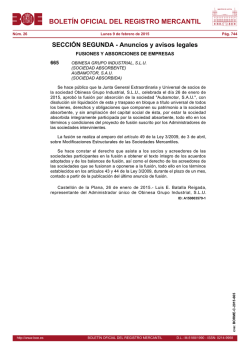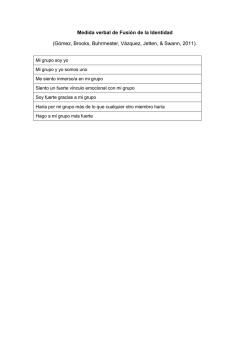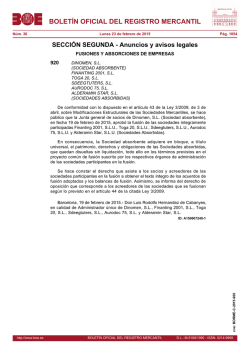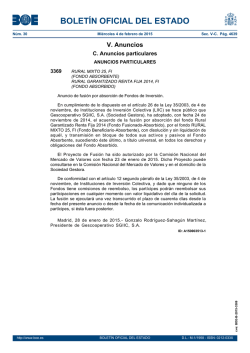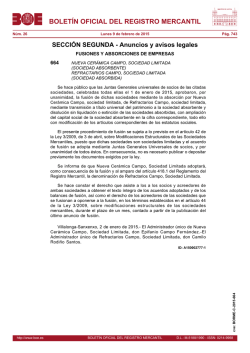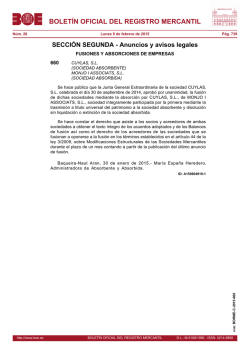
From interpersonal to extended fusion: relationships between fusion
Revista de Psicología Social International Journal of Social Psychology ISSN: 0213-4748 (Print) 1579-3680 (Online) Journal homepage: http://www.tandfonline.com/loi/rrps20 From interpersonal to extended fusion: relationships between fusion with siblings and fusion with the country / Desde la fusión interpersonal a la fusión extendida: Relaciones entre la fusión con los hermanos y la fusión con el país Alexandra Vázquez, Ángel Gómez, Juan R. Ordoñana & Borja Paredes To cite this article: Alexandra Vázquez, Ángel Gómez, Juan R. Ordoñana & Borja Paredes (2015): From interpersonal to extended fusion: relationships between fusion with siblings and fusion with the country / Desde la fusión interpersonal a la fusión extendida: Relaciones entre la fusión con los hermanos y la fusión con el país, Revista de Psicología Social, DOI: 10.1080/02134748.2015.1093755 To link to this article: http://dx.doi.org/10.1080/02134748.2015.1093755 Published online: 07 Oct 2015. Submit your article to this journal View related articles View Crossmark data Citing articles: 1 View citing articles Full Terms & Conditions of access and use can be found at http://www.tandfonline.com/action/journalInformation?journalCode=rrps20 Download by: [UNED] Date: 16 October 2015, At: 03:01 Revista de Psicología Social / International Journal of Social Psychology, 2015 http://dx.doi.org/10.1080/02134748.2015.1093755 From interpersonal to extended fusion: relationships between fusion with siblings and fusion with the country / Desde la fusión interpersonal a la fusión extendida: Relaciones entre la fusión con los hermanos y la fusión con el país Alexandra Vázqueza, Ángel Gómeza, Juan R. Ordoñanab, and Borja Paredesa a Universidad Nacional de Educación a Distancia; bUniversidad de Murcia Downloaded by [UNED] at 03:01 16 October 2015 (Received 26 November 2014; accepted 26 January 2015) Abstract: Identity fusion is a visceral feeling of oneness with a group. Although research on identity fusion focuses on the alignment of individuals with groups, we propose that fusion can develop between two individuals. In particular, we explore for the first time identity fusion between siblings and its relation with endorsement of extreme behaviour to protect the sibling. In a study conducted with 761 couples of siblings we found that fusion with the sibling is positively associated with willingness to fight and die for the sibling. Additionally, we address the relation between interpersonal and extended fusion. Specifically, a positive association between fusion with the sibling and fusion with the country emerged. The hypothesis that extended fusion might require the projection of interpersonal ties to a large category is discussed. Keywords: identity fusion; social identity; personal identity; sibling relationships Resumen: La fusión de identidad es un sentimiento visceral de unidad con un grupo. Aunque la investigación sobre la fusión de identidad se centra en la relación de los individuos con los grupos, proponemos que la fusión puede desarrollarse entre individuos. En particular, exploramos por primera vez la fusión de identidad entre hermanos y su relación con la aprobación de comportamientos extremos para proteger al hermano. En un estudio realizado entre 761 parejas de hermanos hallamos que la fusión con el hermano está asociada de manera positiva con la disposición a luchar y morir por él. Así mismo, abordamos la relación entre la fusión interpersonal y la fusión extendida. En concreto, se apreció una asociación positiva entre la fusión con el hermano y la fusión con el país. Discutimos la hipótesis de que la fusión extendida puede requerir la proyección de vínculos interpersonales sobre una categoría amplia. English version: pp. 1–9 / Versión en español: pp. 10–18 References / Referencias: pp. 18–19 Translated from English / Traducción del inglés: Ainhoa Casado Authors’ Address / Correspondencia con los autores: Alexandra Vázquez, C/ Juan del Rosal, 10 (Facultad de Psicología) 28040 Madrid, España. E-mail: [email protected] © 2015 Fundacion Infancia y Aprendizaje 2 A. Vázquez et al. Downloaded by [UNED] at 03:01 16 October 2015 Palabras clave: fusión de identidad; identidad social; identidad personal; relaciones entre hermanos Identity fusion is a visceral feeling of oneness with a group that predicts pro-group behaviour, including self-sacrifice. The willingness to sacrifice for a group might rest on the extension of familial ties to the whole group and its members, who would be considered by fused individuals as family and/or siblings (Swann et al., 2014). Recent field studies have shown that feelings of brotherhood are involved in the transition from fusion to self-sacrifice for an important value (Atran, Sheikh, & Gomez, 2014) or a company of imaginary kin (Whitehouse, McQuinn, Buhrmester, & Swann, 2014). Even though these studies offer initial evidence that fused individuals extrapolate familial ties to the group, no research to date has addressed fusion with genuine siblings. The main goal of the present research is to check whether fusion with siblings extends to a larger group, in particular, the country. Self-sacrifice for kin Sibling relationships are heterogeneous. A couple of siblings might sacrifice for one another, whereas another couple might break their relationship due to an economic dispute. Despite this diversity, numerous studies have found evidence of nepotism across a variety of behavioural domains (e.g., Kruger, 2003; Stewart-Williams, 2007). Shared genes seem to fuel the willingness to self-sacrifice for a person in danger, as people tend to help kin more than non-kin, especially in life-or-death situations (Burnstein, Crandall, & Kitayama, 1994), which conforms to the postulates of the theory of inclusive fitness (Buss, 2008). However, certain categories of non-kin (e.g., friends) might receive more help than kin (Cialdini, Brown, Lewis, Luce, & Neuberg, 1997). These findings fall in line with recent developments showing that a psychosocial process, identity fusion, might be a proximal cause of personally costly behaviour on behalf of in-group members (Atran et al., 2014; Whitehouse et al., 2014). Identity fusion (Swann, Jetten, Gómez, Whitehouse, & Bastian, 2012) has repeatedly proven to predict willingness to fight and die for in-group members (Gómez et al., 2011; Swann, Gómez, Seyle, Morales, & Huici, 2009) and sacrificing to save in-group members in moral dilemmas (Swann et al., 2014). Local and extended identity fusion Fused individuals do not perceive clear boundaries between the self and the group and, therefore, they are as willing to fight and die for their group as for themselves (Swann et al., 2009). This devotion occurs because fused individuals feel connected with other in-group members through family-like ties (Swann et al., 2012). These familial ties entail a sense of obligation and Downloaded by [UNED] at 03:01 16 October 2015 Interpersonal and extended fusion / Fusión interpersonal y fusión extendida 3 deontological impulse that lead fused individuals to help fellow group members in need (Swann et al., 2014). Members of small groups engage in personal contact with others, share experiences and work together to achieve group goals. In such groups (e.g., families, friends) fusion is local. Nevertheless, individuals can feel extended fusion towards large groups (e.g., country), wherein all members do not know each other personally. In extended fusion relational ties are metaphorical and based on common ancestry, a common cause or an important value rather than on interpersonal interactions (Swann et al., 2012). When fused individuals are given a chance to select one group to die for, people choose mainly their family (Swann et al., 2014). This tendency suggests that family is the group that best embodies the construct of identity fusion. Family members share genes, experiences, resources and common goals in terms of survival. Albeit identity fusion involves seeing group members in familial terms, no research to date has examined fusion with family members. To delve into this issue, the present research explores identity fusion in sibling relationships, which are the longest-lasting bond for most people. Sibling influences may decline in adulthood but for many adults their sibling remains a source of companionship, advice and emotional support (Mikkelson, Floyd, & Paule, 2011). Interpersonal identity fusion Identity fusion research gravitates around individual-group relations. Notwithstanding, people might theoretically feel fused with another individual, a value or a cause. As a matter of fact, the merging of self and other identity has been proposed earlier by the self-expansion theory (Aron & Aron, 1996; Aron, Aron, & Smollan, 1992). According to this model, people can include another person as part of the self. A wide range of studies evidences that the merger of the self and other identity actually occurs, especially under conditions of relationship closeness (Aron et al., 1992; Mashek, Aron, & Boncimino, 2003). This idea of inclusion of other in the self resembles the process of identity fusion between a person and a group. However, whereas the identity fusion approach aims to predict extreme behaviour on behalf of group members, selfexpansion theory is focused on how people self-expand through interpersonal relationships (Aron & Aron, 1996). That is to say, identity fusion emphasizes what people can do for others, but self-expansion theory highlights how others can benefit oneself. Our proposal We are interested in the connection between identity fusion with the sibling and willingness to fight and die for him/her. As previous findings suggest (Gómez 4 A. Vázquez et al. Downloaded by [UNED] at 03:01 16 October 2015 et al., 2011; Swann et al., 2014), feeling highly fused with one’s sibling would encourage endorsement of extreme behaviour for him/her. Additionally, we will explore whether fusion with siblings is related to fusion with a broader category, the country. Fusion with the country is a form of extended fusion, which might require that individuals project the familial ties related to local fusion onto large groups (Swann et al., 2012). Based on this premise, fusion with siblings might facilitate fusion with an inclusive, superordinate category as the country. To provide initial evidence in favour of the link between interpersonal fusion with the sibling and willingness to fight and die for the sibling and extended fusion with the country, we conducted a study with couples of siblings. We hypothesize that fusion with the sibling will predict endorsement of pro-sibling behaviour and will be associated to fusion with the country. Method Participants 1,522 participants (58.4% females, mean age = 32.28, SD = 10.30) completed an online study supposedly designed to explore sibling relationships. A quarter of the participants were students from UNED, who completed a brief questionnaire for course credit. For their participation to be considered valid, each student had to ask his/her sibling and another couple of siblings to take part. There were 321 couples of siblings of mixed gender, 156 couples of men and 284 couples of women. Procedure Participants responded to a brief questionnaire including1 measures of fusion with the sibling, willingness to fight and die for the sibling and fusion with the country, as well as control variables (age and gender). Items for the fusion and willingness to fight and die scales used scales ranging from 1 (totally disagree) to 10 (totally agree). All αs > .71. Identity fusion with the sibling Was measured by an adapted version of the scale of Gómez et al. (2011), consisting of three items (e.g., ‘I am one with my sibling’). Willingness to fight and die for the sibling Was measured by an adapted version of the scale of Swann et al. (2009), consisting of four items (e.g., ‘I would fight someone physically threatening my sibling’). Identity fusion with country Was measured by an adapted version of the scale of Gómez et al. (2011), consisting of three items (e.g., ‘I am one with my country’). Interpersonal and extended fusion / Fusión interpersonal y fusión extendida 5 Results Our analyses include: (1) a correlational analysis to explore the relation between fusion with the sibling, fight and die for the sibling and fusion with the country; (2) a series of regression analyses on fusion with the sibling, willingness to fight and die for the sibling and fusion with the country; and (3) correlational analyses testing the relation of each variable between couples. Downloaded by [UNED] at 03:01 16 October 2015 Correlational analyses As Table 1 shows, fusion with the sibling correlated significantly with fight and die for the sibling and with fusion with the country. Fight and die for the sibling also correlated significantly with fusion with the country. Regression analyses To check the effect of the control variables we conducted three regression analyses on fusion and willingness to fight and die measures, considering as predictors gender (effect coded, −1, 1), gender similarity (effect coded, −1, 1), age (centred) and difference of age in absolute value (centred). As age difference was not significant, ps > .12, this variable was excluded for subsequent analyses. Fusion with the sibling A regression analyses on fusion with the sibling considering as predictors gender, gender similarity and age yielded main effects of gender similarity and age. Fusion was higher in couples of the same gender than in couples of different gender, B = 0.09, t(1,518) = 3.30, p = .001, M = 5.69, SD = 2.24 vs. M = 5.30, SD = 2.28. The higher the age, the lower the fusion with the sibling B = −0.07, t(1,526) = −2.84, p < .01. To check the predictive capacity of fusion with the sibling on fight and die for the sibling and fusion with the country we conducted two stepwise regression analyses. In the first step (Model 1) we introduced the control variables (age, gender and gender similarity). In the second step (Model 2) we added fusion with the sibling to the model. Table 1. Descriptive statistics and correlations. 1. Fusion with the sibling 2. Fight and die for the sibling 3. Fusion with the country Note: **p < .01. M SD 1 2 3 5.52 5.76 2.82 2.26 2.66 2.35 – .41** .31** – .20** – 6 A. Vázquez et al. Table 2. Regression analysis on willingness to fight and die for the sibling. Predictors Block 1 Gender Gender similarity Age Block 2 Fusion Model 1 B Model 2 B 0.07** −0.02 −0.26*** 0.08** −0.05* −0.23*** 0.41*** – R2 = .07 F = 40.65*** ΔR2 = .16*** R2 = .24 F = 118.09*** Downloaded by [UNED] at 03:01 16 October 2015 Note: *p < .05; **p < .01; ***p < .001. Willingness to fight and die for the sibling In the regression on willingness to fight and die for the sibling (see Table 2) the value of R2 increased significantly as compared to Model 1, indicating that fusion with the sibling had a positive effect on willingness to fight and die for the sibling, B = 0.41, t(1,517) = 18.01, p < .001. The significant effect of gender indicated that males were more willing to fight and die for their sibling than females, F(1, 1520) = 11.82, p < .01, η2 = .008, M = 6.03, SD = 2.59 vs. M = 5.56, SD = 2.69. The significant effect of age indicated that the higher the age, the lower the willingness to fight and die for the sibling. Fusion with the country In the regression on fusion with the country (see Table 3) the value of R2 increased significantly as compared to Model 1, indicating that fusion with Table 3. Regression analysis on fusion with the country. Predictors Block 1 Gender Gender similarity Age Block 2 Fusion Model 1 B Model 2 B 0.08** −0.02 0.06* 0.08** −0.05* 0.08** – R2 = .07 F = 4.72** ΔR = .10*** R2 = .11 F = 47.70*** 0.32*** Note: *p < .05; **p < .01; ***p < .001. 2 Interpersonal and extended fusion / Fusión interpersonal y fusión extendida 7 Table 4. Cross-sibling cross-trait correlations. 1. Fusion sibling A 2. Fight die A 3. Fusion country A 1. Fusion sibling B 2. Fight die B 3. Fusion country B .42** .20** .10** .22** .33** .03 .06 .12* .31** Downloaded by [UNED] at 03:01 16 October 2015 Note: **p < .01. the sibling had a positive effect on fusion with the country, B = 0.32, t(1,517) = 13.23, p < .001. The significant effect of gender indicated that males were more fused with the country than females F(1, 1520) = 8.53, p < .01, η2 = .006, M = 3.03, SD = 2.47 vs. M = 2.68, SD = 2.26. The significant effect of age indicated that the higher the age, the stronger the level of fusion with the country. Additional analyses To check whether fusion with the sibling, willingness to fight and die for the sibling and fusion with the country were associated within couples, we calculated the correlations between siblings. As can be seen in the diagonal of Table 4, correlations between scores of each sibling were positive and significant for all variables. The highest correlation corresponds to fusion with the sibling. Correlations between fusion with the sibling in one member of the couple and willingness to fight and die for the sibling in the other member are also positive and significant. Other cross-sibling cross-variable correlations (e.g., between fusion with the sibling in one member of the couple and fusion with the country in the other member) are also positive, but of a lesser magnitude. Discussion Identity fusion involves developing familial ties towards group members (Swann et al., 2012). It is not surprising, therefore, that family is the group for which people are most willing to sacrifice themselves (Swann et al., 2014). Among family relations, we focused on fusion with siblings. Our results substantially contribute to literature about identity fusion by examining for the first time interpersonal fusion and its connection to the willingness to undertake costly actions on behalf of one’s siblings. Additionally, we offered exploratory support for the existence of a projection mechanism from interpersonal fusion with siblings to extended fusion with the country. Our results showed that identity fusion with the sibling was positively associated with extreme behaviour on his/her behalf. Although correlational, this finding seems to suggest that the link between fusion and extreme behaviour also extends to the interpersonal realm. Those participants who felt highly fused Downloaded by [UNED] at 03:01 16 October 2015 8 A. Vázquez et al. with their sibling were more likely to endorse fighting and dying for their sibling as compared with low fused. Males expressed greater willingness to protect their sibling than females. Probably, the potentially violent implications of some items might explain this effect, which is modest in any event. Older couples of siblings were less fused and less willing to fight and die for their peers than younger couples. This effect is not surprising given that sibling relationships might lose importance in adulthood (Lamb, 1982). The present research also suggests that fusion with siblings might facilitate extended fusion with the country. Sibling relationships seem to reify the fusion metaphor better than other links. For instance, when jihadi fighters explain their reasons to fight in Syria, they often allude to an obligation to defend their brothers and sisters. Likewise, when we describe the relationship we have with close friends, we often say they are as brothers or sisters to us. Thus, to perceive and treat fellow countrymen as sisters and brothers it may be beneficial, in the first place, to be fused with one’s siblings. This result should not be interpreted unhesitatingly in dispositional terms, as fusion seems to be unrelated with personality traits (Swann et al., 2009). In fact, fusion is exclusive to a great extent, because such an alignment demands an almost absolute devotion which refrains fused individuals from cultivating affiliation with other groups (Swann et al., 2012). However, when two groups are inclusive (e.g., the region and the country) or share common goals or values (e.g., defending the country against infidels might imply protecting the family from bad influences), being simultaneously fused with several groups becomes possible (see Whitehouse et al., 2014). In view of some recent events involving couples of siblings (e.g., the attack on the satirical magazine Charlie Hebdo in France, the attack in the Boston Marathon, the arrest in Ceuta of two couples of brothers extremely radicalized and ready to attack and self-sacrifice), future research should determine whether fusion with siblings moderates the effect that other factors such as fusion with a superordinate group or sacredness have on willingness to fight and die for a group and/or a cause. Our analyses showed a high degree of correspondence between the scores of siblings in all measures. There seems to be substantial reciprocity in the perception of oneness and willingness to sacrifice for each other among siblings. This result might reflect the influence of kinship norms (De Vries, Kalmijn, & Liefbroer, 2009). These norms are culturally defined and specify how kin-related persons are expected to behave towards each other (Rossi & Rossi, 1990). The strength of feelings of obligation towards family members is modulated by different factors (Rossi & Rossi, 1990). Identity fusion might be one of those factors. Since the present research is exploratory in nature, we must note some shortcomings. We did not register the characteristics of the families where participants come from. Future research should determine whether certain types of families Downloaded by [UNED] at 03:01 16 October 2015 Interpersonal and extended fusion / Fusión interpersonal y fusión extendida 9 (e.g., cohesive, big or authoritarian families, etc.) foster or inhibit feelings of fusion with siblings. Although investigating other family links, as relationships between parents and children might be productive, sibling relationships offer two advantages. First, sibling relationships involve an egalitarian connection that hardly appears in parent-children relationships, as parents usually adopt a protective role towards their offspring. Second, sibling relationships include couples varying in average genetic commonality (twins vs. fraternal siblings). Further research should include twin samples with the aim of testing the influence of genetic relatedness in fusion with the sibling and willingness to protect him/her. Finally, we cannot infer causality because data are correlational. Future longitudinal and experimental studies could shed light on causal relations to determine whether interpersonal and local fusion is a prerequisite for the development of extended fusion. Note 1. Identification with the sibling was measured with an adaptation of the single-item scale of Postmes, Haslam, and Jans (2013). The relevant analyses are available upon request from the first author. 10 A. Vázquez et al. Downloaded by [UNED] at 03:01 16 October 2015 Desde la fusión interpersonal a la fusión extendida: relaciones entre la fusión con los hermanos y la fusión con el país La fusión de identidad es un sentimiento visceral de unidad con un grupo que predice el comportamiento favorable al grupo, incluyendo el auto-sacrificio. La disposición a sacrificarse por un grupo podría basarse en la extensión de los vínculos familiares al grupo entero y a sus miembros, que estarían considerados por los individuos fusionados como familia y/o hermanos (Swann et al., 2014). Recientes estudios de campo han mostrado que los sentimientos de fraternidad están implicados en la transición desde la fusión al auto-sacrificio por un valor importante (Atran, Sheik, & Gómez, 2014) o por un grupo de hermanos imaginado (Whitehouse, McQuinn, Buhrmester, & Swann, 2014). Aunque estos estudios ofrecen evidencias iniciales de que los individuos fusionados extrapolan los vínculos familiares al grupo, hasta la fecha ninguna investigación ha tratado la fusión con los hermanos reales. El principal objetivo de la presente investigación es comprobar si la fusión con los hermanos se extiende a un grupo más amplio, en particular, el país. Auto-sacrificio por los miembros de la familia Las relaciones entre hermanos son heterogéneas. Dos hermanos pueden sacrificarse el uno por el otro, mientras que otros pueden romper su relación por una disputa económica. A pesar de esta diversidad, numerosos estudios han encontrado evidencias de nepotismo en un gran variedad de ámbitos de la conducta (e.g., Kruger, 2003; Stewart-Williams, 2007). El hecho de tener los mismos genes parece incrementar la disposición al auto-sacrifico por la persona que corre peligro puesto que, en conformidad con los postulados de la teoría de la eficacia inclusiva (Buss, 2008), tendemos a ayudar más a nuestros familiares que a las que no lo son, especialmente en situaciones de vida o muerte (Burnstein, Crandall, & Kitayama, 1994). Sin embargo, algunas categorías fuera de la familia (e.g., amigos) pueden recibir más ayuda que la propia familia (Cialdini, Brown, Lewis, Luce, & Neuberg, 1997). Estos hallazgos concuerdan con desarrollos recientes que muestran que un proceso psicológico, la fusión de la identidad, podría ser una causa próxima del comportamiento personalmente costoso en favor de los miembros del grupo (Atran et al., 2014; Whitehouse et al., 2014). Se ha comprobado repetidamente que la fusión de la identidad (Swann, Jetten, Gómez, Whitehouse, & Bastian, 2012) es un predictor de la disposición a luchar y morir por los miembros del propio grupo (Gómez et al., 2011; Swann, Gómez, Seyle, Morales, & Huici, 2009) y al sacrifico para salvar a esos miembros en dilemas morales (Swann et al., 2014). Downloaded by [UNED] at 03:01 16 October 2015 Interpersonal and extended fusion / Fusión interpersonal y fusión extendida 11 Fusión de identidad local y extendida Los individuos fusionados no perciben límites claros entre ellos mismos y el grupo, y están, por tanto, tan dispuestos a luchar y morir por el grupo como por sí mismos (Swann et al., 2009). Esta devoción tiene lugar porque los individuos fusionados se sienten conectados con otros miembros de su grupo a través de vínculos similares a los familiares (Swann et al., 2012). Estos vínculos familiares conllevan un sentido de obligación y un impulso deontológico que lleva a los individuos fusionados a proporcionar ayuda a los compañeros del grupo que la necesitan (Swann et al., 2014). Los miembros de grupos pequeños establecen contacto personal con los demás, comparten experiencias y trabajan juntos para alcanzar objetivos. En esos grupos (e.g., familias, amigos) la fusión es local. Sin embargo, los individuos pueden sentir una fusión extendida hacia grupos amplios (e.g., país), en los que no todos se conocen personalmente. En la fusión extendida los vínculos relacionales son metafóricos y se basan en la ascendencia común, una causa común o un valor importante más que en las interacciones personales (Swann et al., 2012). Cuando se da a los individuos fusionados la oportunidad de elegir un grupo por el que morir, eligen principalmente a su familia (Swann et al., 2014). Esta tendencia sugiere que la familia es el grupo que mejor encarna el constructo de la fusión de identidad. Los miembros de una familia, comparten genes, experiencias, recursos y objetivos comunes en términos de supervivencia. Si bien la fusión de la identidad supone ver a los miembros del grupo en términos de familia, hasta ahora ninguna investigación ha examinado la fusión con los miembros de la familia. Para profundizar en este tema, la presente investigación explora la fusión de la identidad en las relaciones entre hermanos, las cuales son para la mayoría de las personas el vínculo más duradero. La influencia de los hermanos puede declinar en la vida adulta pero muchos adultos siguen encontrando en los hermanos compañía, consejo y apoyo emocional (Mikkelson, Floyd, & Paule, 2011). Fusión de identidad interpersonal La investigación sobre la fusión de identidad gira alrededor de las relaciones individuo-grupo. No obstante, en teoría es posible sentirse fusionado con otro individuo, un valor o una causa. De hecho, la fusión entre la identidad propia y la del otro ha sido propuesta anteriormente por la teoría de la auto-expansión (Aron & Aron, 1996; Aron, Aron, & Smollan, 1992). Según este modelo, una persona puede incluir a otra como parte de su autoconcepto. Una amplia serie de estudios ofrece pruebas de que la fusión de la identidad propia y la del otro realmente ocurre, especialmente en relaciones cercanas (Aron et al., 1992; Mashek, Aron, & Boncimino, 2003). Esta idea de inclusión del otro en uno mismo se asemeja al proceso de fusión de identidad entre la persona y el grupo. Sin embargo, mientras que el enfoque de la fusión de identidad predice un comportamiento extremo en nombre de los miembros del grupo, la teoría de la auto-expansión se centra en cómo las personas 12 A. Vázquez et al. Downloaded by [UNED] at 03:01 16 October 2015 se auto-expanden a través de las relaciones interpersonales (Aron & Aron, 1996). Es decir, la fusión de la identidad enfatiza aquello que uno mismo puede hacer por los demás, mientras que la auto-expansión destaca cómo los demás pueden beneficiar a uno mismo. Nuestra propuesta Estamos interesados en la conexión entre la fusión de la identidad con el hermano/ a y el hecho de estar dispuesto a luchar y morir por él/ella. Como sugieren los hallazgos anteriores (Gómez et al., 2011; Swann et al., 2014), sentirse muy fusionado con un hermano favorecería la aprobación de comportamientos extremos por él o ella. Asimismo, exploraremos si la fusión con los hermanos está relacionada con la fusión con una categoría más amplia: el país. La fusión con el país es una forma de fusión extendida, para la que puede ser necesario que los individuos proyecten sobre grupos amplios los vínculos familiares relacionados con la fusión local (Swann et al., 2012). Según esta premisa, la fusión con los hermanos puede facilitar la fusión con una categoría inclusiva más amplia como el país. Para proporcionar una evidencia inicial en favor de este vínculo entre la fusión interpersonal con el hermano y la disposición a luchar y morir por él y la fusión extendida con el país, realizamos un estudio con parejas de hermanos. Nuestra hipótesis consistía en que la fusión con el hermano prediría la aprobación del comportamiento favorable al hermano y que estaría asociada con la fusión con el país. Método Participantes 1,522 participantes (58.4% mujeres, edad media = 32.28, DT = 10.30) completaron un estudio online supuestamente diseñado para explorar las relaciones entre hermanos. Una cuarta parte de los participantes eran estudiantes de la UNED y rellenaron un breve cuestionario para obtener puntos en el curso. Para que su participación fuera válida, cada estudiante debía pedir a su hermano o hermana y también a otra pareja de hermanos que participaran. Había 321 parejas de hermanos de distinto género, 156 parejas de hermanos y 284 parejas de hermanas. Procedimiento Los participantes respondieron a un breve cuestionario en el que se incluían1 medidas de fusión con el hermano, de disposición a luchar y morir por el hermano y de fusión con el país, así como las variables de control (edad y género). Los ítems para fusión y estar dispuesto a luchar y morir contaban con escalas que iban desde 1 (en total desacuerdo) a 10 (totalmente de acuerdo). Todos las αs >.71. Interpersonal and extended fusion / Fusión interpersonal y fusión extendida 13 Fusión de identidad con el hermano Se midió mediante una versión adaptada de la escala de Gómez et al. (2011), compuesta por tres ítems (e.g., ‘Mi hermano y yo somos uno’). Downloaded by [UNED] at 03:01 16 October 2015 Disposición a luchar y morir por el hermano Se midió mediante una versión adaptada de la escala de Swann et al. (2009), compuesta por cuatro ítems (e.g., ‘Lucharía contra cualquiera que amenazara físicamente a mi hermano’). Fusión de identidad con el país Se midió mediante una versión adaptada de la escala de Gómez et al. (2011), compuesta por tres ítems (e.g., ‘Mi país y yo somos uno’). Resultados Nuestros análisis incluyen: (1) un análisis correlacional para estudiar la relación entre fusión con el hermano, luchar y morir por el hermano y fusión con el país; (2) una serie de análisis de regresión respecto a la fusión con el hermano, estar dispuesto a luchar y morir por el hermano, y fusión con el país; y (3) un análisis correlacional para comprobar la relación de cada una de las variables entre las parejas. Análisis correlacionales Como muestra la Tabla 1, la fusión con el hermano correlacionaba significativamente con luchar y morir por el hermano y la fusión con el país. Luchar y morir por el hermano también correlacionaba significativamente con la fusión con el país. Análisis de regresión Para comprobar el efecto de las variables de control realizamos tres análisis de regresión respecto a las medidas de fusión y disposición a luchar y morir considerando como predictores: género (codificación, −1, 1), similitud de género (codificación, −1, 1), edad (centrado) y diferencia de edad en valor Tabla 1. Estadísticos descriptivos y correlaciones. 1. Fusión con el hermano 2. Luchar y morir por el hermano 3. Fusión con el país Nota: **p < .01. M DT 1 2 3 5.52 5.76 2.82 2.26 2.66 2.35 – .41** .31** – .20** – 14 A. Vázquez et al. Downloaded by [UNED] at 03:01 16 October 2015 absoluto (centrado). Como la diferencia de edad no era significativa, ps > .12, se excluyó la variable de los análisis posteriores. Fusión con el hermano Un análisis de regresión sobre la fusión con el hermano considerando género, similitud de género y edad como predictores arrojó resultados importantes para la similitud de género y la edad. La fusión era mayor en las parejas de hermanos del mismo género que en las parejas de distinto género, B = 0.09, t(1,518) = 3.30, p = .001, M = 5.69, DT = 2.24 vs. M = 5.30, DT = 2.28. A mayor edad, menor era la fusión con el hermano, B = −0.07, t(1,526) = −2.84, p < .01. Para comprobar la capacidad predictiva de la fusión con el hermano respecto a luchar y morir por el hermano y la fusión con el país realizamos dos análisis de regresión por pasos. En el primer paso (Modelo 1) introdujimos las variables de control (edad, género y similitud de género) En el segundo paso (Modelo 2) añadimos al modelo la fusión con el hermano. Disposición a luchar y morir por el hermano En el análisis de regresión respecto a la disposicion a luchar y morir por el hermano (véase Tabla 2) el valor de R2 aumentó significativamente en comparación con el Modelo 1, lo que indica que la fusión con el hermano tenía un efecto positivo sobre la disposición a luchar y morir por el hermano, B = 0.41, t (1,517) = 18.01, p < .001. El efecto significativo del género indica que los varones estaban más dispuestos a luchar y morir por sus hermanos que las mujeres, F(1, 1520) = 11.82, p < .01, η2 = .008, M = 6.03, DT = 2.59 vs. M = 5.56, DT = 2.69. El efecto significativo de la edad indica que a mayor edad, menor era la disposición a luchar y morir por el hermano. Tabla 2. Análisis de regresión sobre la disposición a luchar y morir por el hermano. Predictores Bloque 1 Género Similitud de género Edad Bloque 2 Fusión Modelo 1 B 0.07** −0.02 −0.26*** – R2 = .07 F = 40.65*** Nota: *p < .05; **p < .01; ***p < .001. Modelo 2 B 0.08** −0.05* −0.23*** 0.41*** ΔR = .16*** R2 = .24 F = 118.09*** 2 Interpersonal and extended fusion / Fusión interpersonal y fusión extendida 15 Tabla 3. Análisis de regresión respecto a la fusión con el país. Predictores Bloque 1 Género Similitud de género Edad Bloque 2 Fusión Modelo 1 B Modelo 2 B 0.08** −0.02 0.06* 0.08** −0.05* 0.08** – R2 = .07 F = 4.72** ΔR = .10*** R2 = .11 F = 47.70*** 0.32*** 2 Downloaded by [UNED] at 03:01 16 October 2015 Nota: *p < .05; **p < .01; ***p < .001. Fusión con el país En el análisis de regresión sobre la fusión con el país (véase Tabla 3) el valor de R2 aumentó significativamente en comparación con el Modelo 1, lo que indica que la fusión con el hermano tenía un efecto positivo sobre la fusión con el país, B = 0.32, t(1,517) = 13.23, p < .001. El efecto significativo del género indica que los varones estaban más fusionados con el país que las mujeres, F(1, 1520) = 8.53, p < .01, η2 = .006, M = 3.03, DT = 2.47 vs. M = 2.68, DT = 2.26. El efecto significativo de la edad indica que a mayor edad, mayor era la fusión con el país. Análisis adicionales Para comprobar si la fusión con el hermano, la disposición a luchar y morir por él y la fusión con el país estaban asociadas dentro de las parejas, calculamos las correlaciones entre los hermanos. Como puede verse en la diagonal de la Tabla 4, las correlaciones entre los resultados de cada hermano eran positivas y significativas para todas las variables. La mayor correlación corresponde a la fusión con el hermano. Las correlaciones entre la fusión con el hermano en un miembro de la pareja y la disposición a luchar y morir por su hermano en el otro miembro también resultaron positivas y significativas. Se vieron otras correlaciones cruzadas por Tabla 4. Correlaciones entre hermanos y características cruzadas. 1. Fusión con el hermano B 2. Luchar morir B 3. Fusión con el país B 1. Fusion con el hermano A 2. Luchar morir A 3. Fusión con el país A Nota: **p < .01. .42** .22** .06 .20** .10** .33** .03 .12* .31** 16 A. Vázquez et al. Downloaded by [UNED] at 03:01 16 October 2015 hermanos y por variable positivas, pero de menor magnitud (e.g., entre fusión con el hermano en un miembro de la pareja y fusión con el país en el otro miembro). Discusión La fusión de identidad supone el desarrollo de vínculos familiares con los miembros del grupo (Swann et al., 2012). No resulta sorprendente, por tanto, que la familia sea el grupo por el que estemos más dispuestos a sacrificarnos (Swann et al., 2014). Dentro de las relaciones familiares, nos centramos en la fusión con los hermanos. Nuestros resultados contribuyen de manera significativa a la literatura sobre la fusión de la identidad puesto que se examina por primera vez la fusión interpersonal y su conexión con la disposición a emprender acciones costosas en favor de un hermano. Además, ofrecemos evidencia exploratoria que apoya la existencia de un mecanismo de proyección desde la fusión interpersonal con los hermanos a la fusión extendida con el país. Nuestros resultados mostraron que la fusión de identidad con el hermano estaba asociada de manera positiva con el comportamiento extremo para ayudarle. Aunque sea de tipo correlacional, estos hallazgos parecen sugerir que el vínculo entre fusión y comportamiento extremo también se extiende al ámbito interpersonal. Los participantes que se sentían muy fusionados con su hermano aprobaban con mayor probabilidad el luchar y morir por su hermano en comparación con los poco fusionados. Los varones indicaron una mayor disposición a proteger a sus hermanos que las mujeres. Probablemente, las implicaciones potencialmente violentas de algunos de estos ítems pueden explicar este efecto, que en cualquier caso, no es muy marcado. Las parejas de hermanos de más edad estaban menos fusionadas y menos dispuestas a luchar y morir por sus pares que las parejas más jóvenes. Este efecto no es sorprendente, dado que las relaciones entre hermanos pueden perder importancia en la edad adulta (Lamb, 1982). La presente investigación también apunta a que la fusión con los hermanos puede facilitar la fusión extendida con el país. Las relaciones entre hermanos parecen reificar mejor que otros vínculos la metáfora de fusión. Por ejemplo, cuando los yihadistas explican sus razones para combatir en Siria, a menudo aluden a la obligación de defender a sus hermanos y hermanas. Igualmente, cuando describimos la relación con amigos íntimos, a menudo decimos que son como hermanos o hermanas. Por tanto, para percibir y tratar a los compatriotas como hermanas y hermanos podría ser conveniente, en primer lugar, estar fusionado con los hermanos. Este resultado no debería interpretarse sin reservas en términos disposicionales, porque la fusión parece no estar relacionada con los rasgos de personalidad (Swann et al., 2009). De hecho, la fusión es exclusiva en gran medida, porque tal relación exige una devoción casi absoluta que hace que los individuos fusionados se abstengan de cultivar afiliaciones con otros grupos (Swann et al., 2012). Sin embargo, cuando un grupo está contenido en el otro (e.g., región y país) o los dos grupos comparten objetivos y valores (e.g., defender el país frente a los infieles puede implicar proteger a la familia de las malas influencias), se hace posible la fusión simultánea con varios grupos (véase Whitehouse et al., 2014). Downloaded by [UNED] at 03:01 16 October 2015 Interpersonal and extended fusion / Fusión interpersonal y fusión extendida 17 A la vista de algunos acontecimientos en los que han participado parejas de hermanos (e.g., el ataque en el semanario satírico Charlie Heddo en Francia, el atentado en el maratón de Boston, el arresto en Ceuta de dos parejas de hermanos muy radicalizados y que estaban dispuestos a atacar y al auto-sacrificio), las investigaciones futuras deberían determinar si la fusión con los hermanos modera el efecto que otros factores, como pueden ser la fusión con un grupo más amplio o los valores sagrados, tienen en la disposición para luchar y morir por un grupo y/o una causa. Nuestro análisis mostró un alto grado de correspondencia entre los resultados de los hermanos en todas las medidas. Parece haber una reciprocidad substancial en la percepción de ‘ser uno con’ y la disposición al sacrificio mutuo entre los hermanos. Este resultado parece reflejar la influencia de las normas de parentesco (De Vries, Kalmijn, & Liefbroer, 2009). Estas normas están definidas de manera cultural y especifican cómo se espera que se comporten mutuamente los miembros de la familia (Rossi & Rossi, 1990). El fortalecimiento de los sentimientos de obligación respecto a los familiares viene modulado por diferentes factores (Rossi & Rossi, 1990). La fusión de identidad podría ser uno de esos factores. Como la presente investigación es una exploración inicial, hemos de señalar algunas limitaciones. No registramos las características de las familias de los participantes. Las futuras investigaciones deberían determinar si algunos tipos de familias (e.g., cohesionadas, grandes o autoritarias, etc.) favorecen o inhiben los sentimientos de fusión con los hermanos. Aunque la investigación de otros vínculos familiares entre padres e hijos puede ser productiva, las relaciones entre hermanos ofrecen dos ventajas. En primer lugar, las relaciones entre hermanos suponen una conexión igualitaria que difícilmente aparece en las relaciones padres-hijos, puesto que los padres normalmente adoptan un rol protector hacia su descendencia. En segundo lugar, las relaciones entre hermanos incluyen parejas con diferencias en la semejanza genética media (gemelos frente a hermanos no gemelos). Las investigaciones adicionales deberían incluir muestras con gemelos para comprobar la influencia de la semejanza genética en la fusión con el hermano y en la disposición para protegerlo. Finalmente, no podemos inferir causalidad ya que los datos son de tipo correlacional. Futuros estudios longitudinales y experimentales podrían arrojar luz sobre las relaciones causales para determinar si la fusión interpersonal y local es un prerrequisito para el desarrollo de la fusión extendida. Nota 1. La identificación con el hermano se midió con una adaptación de la escala de ítem único de Postmes, Haslam, y Jans (2013). Los análisis relevantes están disponibles bajo petición a la primera autora. Acknowledgements / Agradecimientos For funds that facilitated this research, we acknowledge Universidad Nacional de Educación a Distancia (Grant 2013-004-UNED-PROY to Alexandra Vázquez), Spanish Ministry of Economy and Competitiveness (Grant PSI2012- 30921 to Ángel Gómez) and 18 A. Vázquez et al. Fundación Séneca — Regional Agency for Science and Technology, Murcia, Spain (Grant 15302/PHCS/10 to Juan R. Ordoñana). / Nuestro reconocimiento por la financiación recibida a las siguientes instituciones: Universidad Nacional de Educación a Distancia (Subvención 2013-004-UNED-PROY a Alexandra Vázquez), Ministerio Español de Economía y Competitividad (Subvención PSI2012- 30921 a Ángel Gómez) y Fundación Séneca — Agencia Regional para la Ciencia Y Tecnología, Murcia, España (Subvención 15302/PHCS/10 a Juan R. Ordoñana). Disclosure statement No potential conflict of interest was reported by the authors / Los autores no han referido ningún potencial conflicto de interés en relación con este artículo. Downloaded by [UNED] at 03:01 16 October 2015 References / Referencias Aron, E. N., & Aron, A. (1996). Love and expansion of the self: The state of the model. Personal Relationships, 3, 45–58. doi:10.1111/pere.1996.3.issue-1 Aron, A., Aron, E. N., & Smollan, D. (1992). Inclusion of other in the self scale and the structure of interpersonal closeness. Journal of Personality and Social Psychology, 63, 596–612. doi:10.1037/0022-3514.63.4.596 Atran, S., Sheikh, H., & Gomez, A. (2014). Devoted actors sacrifice for close comrades and sacred cause. Proceedings of the National Academy of Sciences, 111, 17702– 17703. doi:10.1073/pnas.1420474111 Burnstein, E., Crandall, C., & Kitayama, S. (1994). Some neo-Darwinian decision rules for altruism: Weighing cues for inclusive fitness as a function of the biological importance of the decision. Journal of Personality and Social Psychology, 67, 773– 789. doi:10.1037/0022-3514.67.5.773 Buss, D. (2008). Evolutionary psychology. The new science of the mind (3rd ed.). Boston, MA: Pearson. Cialdini, R. B., Brown, S. L., Lewis, B. P., Luce, C., & Neuberg, S. L. (1997). Reinterpreting the empathy–altruism relationship: When one into one equals oneness. Journal of Personality and Social Psychology, 73, 481–494. doi:10.1037/00223514.73.3.481 De Vries, J., Kalmijn, M., & Liefbroer, A. C. (2009). Intergenerational transmission of kinship norms? Evidence from siblings in a multi-actor survey. Social Science Research, 38, 188–200. doi:10.1016/j.ssresearch.2008.09.005 Gómez, A., Brooks, M. L., Buhrmester, M. D., Vázquez, A., Jetten, J., & Swann, W. B. Jr. (2011). On the nature of identity fusion: Insights into the construct and a new measure. Journal of Personality and Social Psychology, 100, 918–933. doi:10.1037/a0022642 Kruger, D. J. (2003). Evolution and altruism: Combining psychological mediators with naturally selected tendencies. Evolution and Human Behaviour, 24, 118–125. doi:10.1016/S1090-5138(02)00156-3 Lamb, M. E. (1982). Sibling relationships across the life span: An overview and introduction. In M. E. Lamb & B. Sutton-Smith (Eds.), Sibling relationshpis: Their nature and significance across the lifespan (pp. 1–11). Hillsdale, NJ: Lawrence Erlbaum Associates. Mashek, D. J., Aron, A., & Boncimino, M. (2003). Confusions of self with close others. Personality and Social Psychology Bulletin, 29, 382–392. doi:10.1177/ 0146167202250220 Mikkelson, A. C., Floyd, K., & Paule, P. M. (2011). Differential solicitude of social support in different types of adult sibling relationships. Journal of Family Communication, 11, 220–236. doi:10.1080/15267431.2011.554749 Downloaded by [UNED] at 03:01 16 October 2015 Interpersonal and extended fusion / Fusión interpersonal y fusión extendida 19 Postmes, T., Haslam, S. A., & Jans, L. (2013). A single-item measure of social identification: Reliability, validity, and utility. British Journal of Social Psychology, 52, 597– 617. doi:10.1111/bjso.2013.52.issue-4 Rossi, A., & Rossi, P. (1990). Of human bonding. New York, NY: Aldine de Gruyter. Stewart-Williams, S. (2007). Altruism among kin vs. nonkin: Effects of cost of help and reciprocal exchange. Evolution and Human Behaviour, 28, 193–198. doi:10.1016/j. evolhumbehav.2007.01.002 Swann, W. B. Jr., Buhrmester, M. D., Gómez, A., Jetten, J., Bastian, B., Vázquez, A., . . . Zhang, A. (2014). What makes a group worth dying for? Identity fusion fosters perception of familial ties, promoting self-sacrifice. Journal of Personality and Social Psychology, 106, 912–926. doi:10.1037/a0036089 Swann, W. B. Jr., Gómez, Á., Buhrmester, M. D., López-Rodríguez, L., Jiménez, J., & Vázquez, A. (2014). Contemplating the ultimate sacrifice: Identity fusion channels pro-group affect, cognition, and moral decision making. Journal of Personality and Social Psychology, 106, 713–727. doi:10.1037/a0035809 Swann, W. B. Jr., Gómez, A., Seyle, D. C., Morales, J., & Huici, C. (2009). Identity fusion: The interplay of personal and social identities in extreme group behaviour. Journal of Personality and Social Psychology, 96, 995–1011. doi:10.1037/a0013668 Swann, W. B. Jr., Jetten, J., Gómez, A., Whitehouse, H., & Bastian, B. (2012). When group membership gets personal: A theory of identity fusion. Psychological Review, 119, 441–456. doi:10.1037/a0028589 Whitehouse, H., McQuinn, B., Buhrmester, M., & Swann, W. B. (2014). Brothers in arms: Libyan revolutionaries bond like family. Proceedings of the National Academy of Sciences, 111, 17783–17785. doi:10.1073/pnas.1416284111
© Copyright 2025
